Lesson Two: The Origins of Western Democratic Liberalism
| Site: | MoodleHUB.ca 🍁 |
| Course: | Social 30-2 RVS |
| Book: | Lesson Two: The Origins of Western Democratic Liberalism |
| Printed by: | Guest user |
| Date: | Monday, 27 October 2025, 8:15 AM |
1. Introduction
The Origins of Western Democratic Liberalism
Duration - 4 blocks ( 80 mins each + homework)
Like the Haudenosaunee Great Law of Peace, classical liberalism is based on the idea of individual freedom, provided it does not infringe on the liberty of others. This means that I am free to do as I please as long as I do not disturb my neighbour or take away the freedom of anyone else.
According to liberal thinkers, freedom and liberty are necessary for people to be able to develop all their talents. Society is free only if all people are free. As well, liberals believe that all people need to be equal before the law. It does not matter if one is rich or poor, legally everyone is to be treated the same. This was not always the case.
2
2. Lesson 3.2.1 The Development of Classical Liberalism
The Development of Classical Liberalism
During the Enlightenment period in Europe in the 18th century, many questioned why a king got to rule without question (absolute monarchy). A concept called rule of law developed from this.
Basic Principles of the Rule of Law
The basic principle of the rule of law is that no one individual is above the law. Regardless of who you are, you are responsible for your actions. No individual is greater than the law.
As individuals began to support the idea of rule of law, many began to believe they were able to govern themselves and did not need a monarch or ruler. Liberalism is a concept that came from many great thinkers. These great thinkers studied the structure of society. From that study, they decided how society could best be served. Jean Jacques Rousseau, a liberal philosopher from the Enlightenment, felt that people should be able to choose their country's leader. He felt people should enter into a social contract with society.
Classical Liberalism
Classical liberalism is a political and economic term used to describe a period of time that began at the end of the 18th century (1700s) when European governments changed to interfere very little in economic decisions. Classical liberal thought developed from the values of individualism and the influential ideas of liberal-minded philosophers.
If you lived in a classical liberal world, you would have total freedom to choose how to live. You could choose what you thought your needs and wants are, and you would work your hardest to do the best you can. If everyone did this, classical liberals argued that then everyone would prosper and society would flourish.

Jean Jacques Rousseau
3. Lesson 3.2.2 About Economic Systems

Economic Decision Making
About Economic Systems
Every day you make dozens of decisions. You might decide to go to work or to a movie, buy the expensive headphones or the cheaper ones. These decisions are all economic decisions. All individuals and all groups
in every society face similar economic decisions because it seems there is "just never enough to go around."
Every country or society has citizens with unlimited wants and needs but only limited resources to meet those wants and needs. In other words, there are never enough resources to fulfill everyone's wants and needs. There are
limited amounts of resources — "just never enough to go around." This produces the basic economic problem of scarcity.
Scarcity forces individuals and society to make choices when answering the three basic economic questions:
-
What goods should be produced? Should only those goods that satisfy people's basic needs be produced or should there be other goods as well? Who should decide this — the government, businesses, or the people?
-
How should goods be produced? What's the best way to make the goods given the resources available? Who should decide this: the government, businesses, or the people?
- Who should get the goods (how should they be distributed)? Should only those who can afford to pay for the goods get them or should everyone have equal access? Who should decide this: the government, businesses, or the people?
While answering the basic economic questions, societies must also consider making the best use of their limited resources called means of production:
-
land: natural resources used in the production of goods and services.
-
labour: work done by humans used in the production of goods and services.
-
capital: the buildings, money, and equipment used in the production of goods and services.
The following video will provide a basic introduction to economic systems.

The following diagram is an economic model that summarizes how countries organize their economic systems to solve the problem of scarcity. When you look at this model of a economic system, you will see the essential features of any economic system:

An Economic System
-
is the organized way in which decisions are made about how resources will be used in a society
-
is an organized model for decision making about the distribution of limited resources
-
includes basic resources of society—land, labour, and capital—known as the means of production
-
includes unlimited demands made for the limited resources
-
includes decisions—individualism or collectivism—that must be made because of limited resources (scarcity)
-
decides what goods will be produced
-
decides how goods will be produced
-
decides how goods will be distributed

Beliefs About Decision Making
Individualism or Collectivism?
This model demonstrates how a society organizes its economic system but the direction the economic system takes is based on one of the following ideologies or perhaps a combination of both:
-
Individualism: businesses and people make economic decisions about scarcity without government involvement, which benefits the common good.
-
Collectivism: government makes economic decisions about scarcity for the common good of the collective group.
4. Lesson 3.2.3 Classical Economic Liberalism
Classical liberalism takes an individualistic approach to an economic system.

Before 1750, life was not easy in the towns and farms of England. People had to work hard, and the primitive methods of farming were not very productive. Most work was done by hand with simple tools or with the help of animals. This method, a feudal system used for centuries, was slow and did not produce enough food for a growing population. In addition, only a limited amount of wealth could be produced under the old feudal system. Laws allowed very limited personal freedoms for most people.
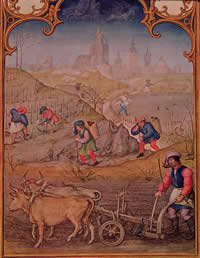
Agricultural Scene
A Farm During the 17th Century
At the end of the 17th century (1600s), the economy of Europe was based on agriculture, as it had been for hundreds of years. Most Europeans lived on farms. Men and women laboured on the land, plowing fields and sowing crops, reaping harvests and storing grain.
Farming methods had not progressed much and farmers still relied upon a few simple home-made tools such as the wooden plow, the hoe, and the scythe. Animal and human muscle provided the power needed to farm the land.|
|
|---|
During the 1600s and 1700s, the economic system of mercantilism introduced the world to new trade markets. Mercantilism was an economic system based on the following:
-
The wealth of a country measured in gold and silver
-
Trade surpluses where a country needed to sell more than it bought by seeking out new trade markets overseas
-
Establishment of colonies to get resources and provide markets for selling goods
-
Government (absolute monarchies) regulation of business
-
Government-controlled monopolies in which only a few business were allowed to trade so profits were made mostly by government and a few businessmen
The new overseas markets introduced European entrepreneurs to new products, industry, machinery, and ways of life. In turn, international trade caused social and economic changes in Europe and helped initiate what became known as the Industrial Revolution.
Please watch the following video explain the Agricultural Revolution which helped lead to the Industrial Revolution:
The Industrial Revolution began with the textile industry in Great Britain around 1750 and reached its peak in 1850. The Industrial Revolution moved Great Britain from an agricultural society to an industrial society. Industrialization meant an increase in profits for those capitalists willing to risk their money in business. New businesses meant new products and a growth in new business.
Please watch the following video on the Industrial Revolution
Video:
Economic changes in Europe during the Industrial Revolution were based on individualism and gave rise to classical liberal ideology.
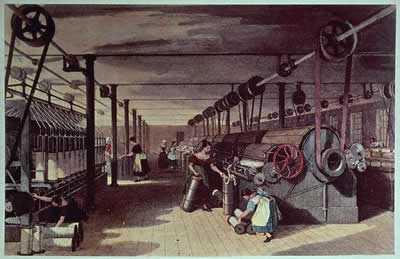
Factory Scene
A Textile Factory during the 19th Century
By the end of the 19th century (the 1800s) the economy of Europe was based on industrial production. Farmers were using factory-built machinery that could do the work of many men. Items that had been made by hand with simple tools were now made by machines in factories. Many Europeans had moved away from the countryside to work in factories located in cities. Animal and human muscle power was eventually replaced by steam engines.
5. Lesson 3.2.4 Adam Smith
Adam Smith and Classical Economic Liberalism
Adam Smith (1723-1790) and Classical Economic Liberalism
The spread of industrialization was helped by the ideas of Enlightenment thinkers influencing the political, economical, and social structure of society. One very influential thinker was Adam Smith. He theorized about classical liberalism and economics.

Adam Smith
Adam Smith disagreed with the economic practices of mercantilism. In his book, The Wealth of Nations (1776), Smith promoted capitalism because he believed in economic freedoms based on individualism. His belief was that, if entrepreneurs (or business owners) were free to determine what was to be produced and were able to profit from these business ventures, these entrepreneurs would then pay the employees a fair salary. A win-win situation.
Smith believed that governments should not control how producers and consumers bought or sold products in the market. Instead, Smith said the market should be laissez-faire or without government intervention:
Let entrepreneurs determine the supply of goods based on demand from consumers.
Let competition and supply and demand determine the prices of goods and services.
The common good will be taken care of if the economy is left in the hands the producers and consumers.
Examine the following chart illustrating the basic differences between mercantilism and Adam Smith's classical economic liberalism or capitalism:
|
Mercantilism Economic System
|
Capitalism Economic System
|
|
Government Intervention: Government has a large role in regulating business.
|
Government Intervention: Government has little or no role in regulating business.
|
|
Business and the Market: In the system of monopolies, a few large businesses, government-created or approved, control the market.
|
Business and the Market: In the system of competition, many businesses, both large and small, compete in the market with no government regulations.
|
|
Wealth: Government and a few favoured businessmen in society control wealth.
|
Wealth: The distribution of wealth occurs among many people in society with no government control.
|
Adam Smith believed that by limiting government intervention and using laissez-faire economics, the perfect economy could be constructed.
Laissez-faire capitalism is a classical liberal economic system based on the ideas of Adam Smith. It is a form of capitalism based on the idea that the government does not get involved in economic decisions and does little to protect workers. There is no government intervention in a laissez-faire capitalist economy.
Some basic principles of classic economic liberalism according to Adam Smith:

OR, put another way, consider the following Adam Smith economic recipe:

How does classical liberalism approach an economic system?
The direction classical liberalism takes economically is based on individualism

-
Limited resources (means of production) of land, labour, and capital should be owned or controlled by individuals.
-
The economic questions of what, how, and for whom to produce will be answered by the interaction of consumers and producers in the market.
-
The government should have no control over ownership of anything in the market.
-
The common good will benefit through the economic values of individual economic freedom, competition, self-interest, and private property.
6. Lesson 3.2.5 Liberal Ideas on Political Systems
Classical Liberal Ideas about Political Systems

Before the late 1700s, in feudal Europe of the past, most people lived in the same area in which they had been born. They did the same work as their parents. Most Europeans were poor and uneducated. The chance that their quality of life would improve was very small. They lived a very traditional way of life with very few individual rights. There was a definite class system in which a very small number of powerful people made and enforced the rules-often for their own benefit.
For example, before the French Revolution of 1789, France had a feudal class system, which had been in place for many centuries. Everyone belonged to one of the three classes of French society called estates. The majority of people occupied the lowest class or Third Estate. Most of of the Third Estate were classified as peasants. They did not have any legal rights. Rules were made by the monarch.
Please watch the following video explain the French Revolution
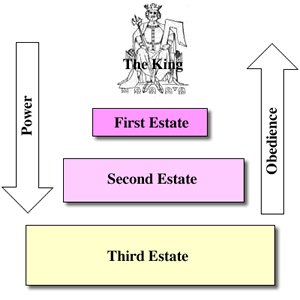
The Estate System
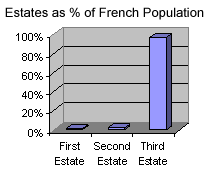
Estates as a % of the French Population
Feudal French Class System
The French monarch inherited most of the power and did not have to obey or respect the law. The King had any rights and freedoms he wanted. France was his kingdom.
The First Estate was made up of the clergy. The Roman Catholic clergy had many rights and freedoms. They did not pay taxes, and they owned much land. The clergy had some say in how they were governed.
The Second Estate was made up of the nobility. They had many rights and freedoms. They did not pay taxes, and they owned most of the land. The nobility had some say in how they were governed.
The Third Estate was made up of peasants, workers, and merchants. This group made up 97% of the population. They were the poorest people in France, and yet, they paid all the taxes. The Third Estate had very few individual rights and freedoms. They had absolutely no say in how they were governed. There was little hope that their lives would ever change.
The class systems of other European kingdoms at this time were very similar to that in France.However, with the Enlightenment, society did begin to change. New ideas about individual rights and freedoms were explored by the great thinkers such as Locke, Rousseau, and Hobbes. These ideas began to spread and would be shared by thousands of people around the world. Gradually, ideas about people having a say in government made their way into government policies. Eventually, this led to the liberal democracies of today in Europe, North and South America, and many other parts of the world.
7. Lesson 3.2.6 John Stuart Mill

John Stuart Mill
John Stuart Mill (1806-1873) and Classical Political Liberalism
John Stuart Mill was a political thinker who believed that most people are logical and rational and will behave appropriately. He believed that there was no need for strict government control. Mill felt that society did not need restrictions. He questioned the need for laws that would restrict individual freedom to choose. Mill believed that the common good would benefit from placing the least amount of restrictions possible on individual rights and freedoms.
Mill argued that legal and political freedoms would create a society that would provide more liberty for all. He believed that government should
have a limited role in restricting the rights and freedoms of individuals
maintain and protect the rule of law
protect private property
protect the rights and security of the individual
Some basic principles of classic political liberalism according to John Stuart Mill are the following:

To reinforce the ideas you just learned about please read pages 101-110 in your textbook, Understandings of Ideologies. Answer the following questions as you complete your reading.
The Origins of Western Democratic Liberalism (p. 101-110)
1. Examine the diagram on page 103. How was society structured in Europe between the 1700’s and 1800’s?
2. What revolution was taking place during this time? Give a minimum of three examples of how it changed peoples’ lives. (p. 102, paragraph 3)
3. Read the caption attached to figure 4-6. Why did liberalism begin to develop in Europe during this period?
4. Whose writing challenged the traditional economic ways of thinking? What were his main criticisms of mercantilism? (p. 103, paragraphs 3, 4)
5. Explain how he thought competition and self interest would create a strong economy? (p. 104, paragraph 1)
6 Explain the “invisible hand.” (p. 104 paragraph 1)
7. Examine figure 4-8 and read the text with it. Explain the law of “supply and demand.”
8. What are the advantages of capitalism over mercantilism? (another thinking question)
9. How do Smith’s ideas reflect the values of classic liberalism. (yup, another thinking one)
10. What are the key political elements of liberal democracy?
(p. 106, paragraph 1)
11. What ideas did John Stuart Mill contribute to the ideas of liberalism?
(p. 107, paragraph 2)
12. Examine the “Voices Box” on page 108 and answer questions 1-3.
13. How does classical liberalism differ from modern liberalism?
(your last thinking question of the worksheet)
Self check your answers here.8. Conclusion
The Western European origins of liberalism trace their roots back to significant events. The Renaissance period (14th to 17th century) in Europe saw the emergence of a modern spirit individualism, which is a central characteristic of liberalism. By the end of the 18th century, revolutions had taken place in America and in France to establish governments based on the liberal values of freedom and democracy. The Industrial Revolution during the late 18th and early 19th century in western Europe and North America transformed economic systems. Classical liberal values led to laissez-faire capitalism, as described by Adam Smith. Later, during during the mid-19th century, John Stuart Mill advanced Smith's ideas into the political and social realms, and moved them toward what would come to be known as modern liberalism.
To summarize, how does classical liberalism approach a political system? The direction classical liberalism takes politically is based on individualism
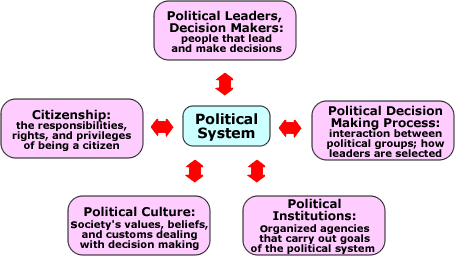
-
Political leaders and decision-makers should come from the people.
-
Political decision-making process should be open to all individuals in society.
-
Political leaders and decision-makers should be selected by society in general.
-
Government decision making role should be limited to providing security to individuals and protecting private property.
-
Political institutions should be limited in power and their goal should be to protect individual rights and freedoms.
-
Political culture should be based on individual rights and freedoms.
-
Citizen responsibilities should be not to cause harm to others.
-
Citizen individual rights and freedoms should be unlimited, provided they don't interfere with the rights and freedoms of others; much like if one lived in a jungle
-
The common good will benefit from everyone having equal individual rights and freedoms.